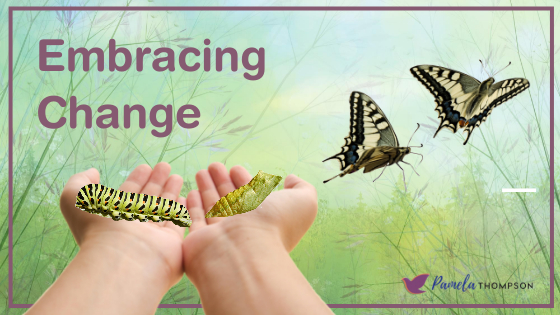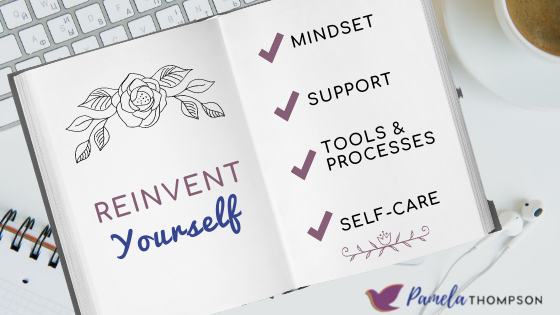
by pam | Jan 18, 2023 | Art of Change, Change, Life Transitions
What is the difference between a life change and a life transition? A life change is external and situational; something tangible such as a separation agreement or a “pink slip” when you lose a job. Whereas a life transition is internal and psychological. It is the internal work we do to reorient and readjust ourselves to our new external reality.[1]
Many of us do the life change but do not do what I call the “transition journey work”. When we only do the life change, we often keep repeating the same patterns in our lives and become frustrated and unfulfilled. An example is someone who consistently chooses new positions for the money without understanding and choosing based on their passions and what makes their soul sing. Another is someone who marries three, four or five times and after the initial honeymoon phase ends up in each relationship dealing with the same issues again and again and again, and either stays in the relationship and remains unhappy and unfulfilled or leaves and starts the process again.
The Benefits of doing the Internal Work
When we commit and take the time to do the internal psychological work and switch our beliefs and actions from resisting to embracing change, we no longer perceive change as a threat.
So how do you learn to embrace change and view it as a creative process that opens you up to new possibilities?
By understanding yourself and how you respond to change and why. And having a framework and tools to support you to navigate the journey.
The Art of Change Framework
Based on over 30 years of experience working with people and organizations in volatile environments including conflict zones, I created the “Art of Change Framework”. It is based on the metaphor “life is a dance” and underpinned by the belief that “embracing change is a creative process that opens us up to new possibilities.” Faced with yet another life transition, I decided to apply the “Art of Change Framework” to that transition and document the journey so I could share it with others.
On October 7, 2022, I had hip replacement surgery for my left hip. Due to osteoarthritis, I hardly had any cartilage left in it. That was the first major surgery I’d had.
My Transition Journey: Applying the “Art of Change Framework”
Step 1 – The first step in the “Art of Change Framework” is Shine the Light. This is where you explore how you respond to change and why.
Rate yourself on a scale from 1 to 10 in terms of how you typically respond to change “1” being “scares me to death” and “10” being “I thrive on it”. I rate myself as a “9” as I typically enjoy change and starting and experiencing new things. Perhaps you relate. The next activity is Rate yourself on a scale from 1 to 10 in terms of how you typically respond to a change that is imposed on you and that “comes out of the blue” such as when you receive a lay-off notice or when your partner says they no longer love you. I rate myself as a “6” on this scale.
Step 2 – Choose Your Dance – This is where you choose the transition you want to focus on, as it is preferable to focus on one transition at a time. The transition I’m choosing to focus on is my hip replacement surgery.
Step 3 – Feel the Rhythm and Learn the Steps – In this step you begin doing the work associated with where you are on your transition journey that includes: 1) an ending; 2) a neutral zone; and 3) a new beginning (adapted from the work of William Bridges). Each phase has work associated with it. The work associated with the ending is letting go and identifying lessons learned.
What did I have to let go of as part of my hip replacement surgery?
- Fear I had about “going under the knife”
- The emotions associated with grief; losing my once healthy hip, the one that had enabled me to run, jump, swim, hike … for all those years
- The belief that I had somehow caused my hip cartilage to deteriorate based on all of the track and field, running, and jumping and other sports I have done since my youth
- My independence as I had to let my partner and others support me during my recovery
- The ability to do activities I regularly do such as yoga, walking in nature, swimming, hiking …
- The belief that I’m getting old and as we age our health declines.
Step 4 – Practice, Practice, Practice – This step involves embracing change in your body and continuing to do the work associated with the phase of the transition journey you are in.
As part of the ending phase above, what lessons did I learn from the experience?
- Patience; I had to learn that recuperating from this type of surgery takes time; at least three to six months
- To reach out and ask for support
- To receive and be okay depending on the physical and emotional support of others
- What an amazing caregiver my partner Alan is
- I am challenged to sit still and not be physically active
- This provided me the opportunity to pause, reflect and take stock of my life and identify the many people and things I am grateful for
- I received the insight that as it was my left hip that was replaced, it is representative of my feminine side. Perhaps my new hip will have “amped up” my feminine energy and help me to spend more time in flow and move forward more quickly and easily without driving and striving.
The neutral zone is the phase between the ending and the new beginning. The work of this phase is to get clear and envision the life, relationship, career of your dreams. It provides an opportunity to create and visualize what your new life will look and feel like. This can also be a fearful place as you have “taken the leap”, are entering unknown territory, and you’re not sure what’s on the other side or whether there is a net to catch you.
I could have chosen not to go on the surgical wait list about a year ago, but after encouragement from my partner I said yes.
What will my new life look like? I see myself:
- playing with my grandkids, going up and down slides with them (including water slides), climbing on recreational equipment
- kayaking with my Sweetie, going on motorcycle rides, and feeling comfortable on the back of Alan’s motorbike
- awakening each day feeling whole, healthy and without pain
- hiking and walking with friends and family on a regular basis
- doing yoga three or more times a week
- believing that life continues to be an adventure to be lived to the fullest
Step 5 – Share Your Dance with the World – In this step, due to the positive ways you respond to change, you inspire and are a positive role model for others.
In Conclusion
Applying the “Art of Change Framework” to my recent hip replacement experience reaffirmed for me that the 5-step “Art of Change Framework” and process takes you on a journey that transforms you from resisting and fearing change to moving through personal and professional transitions with greater ease, grace, and playfulness, resulting in increased clarity and confidence.
If the “Art of Change Framework” resonates for you, I encourage you to apply it to your own personal and professional transitions. I welcome your comments and questions below.
[1] Bridges, William, Transitions; Making Sense of Life’s Changes. Cambridge: Da Capo Press, 2004.

by pam | Oct 20, 2022 | Change, Coping with Change, Life Transitions
For some time, I have questioned whether we can truly manage change whether it be in our personal, or our professional lives.
I would like to propose that instead of “managing change” we explore a new way of thinking about change. Managing something to me means we have control over it. Do we really have control when something comes at us out of the blue or is imposed on us such as when we get laid off or when our partner says they no longer love us?
What if you made friends with change and talked about embracing change rather than managing it? What might that look and feel like?
I have developed a 5-step Art of Change Framework underpinned by the belief that embracing change is a creative process that opens us up to new possibilities and based on the metaphor that life is a dance.
This framework includes a process where you explore how you typically respond to change and why, and then receive tools and a framework to guide you on your transition journey.
The Art of Change Framework is underpinned by evidence from neuroscience, organizational development, the health-promoting and healing benefits of the arts, and eastern psychology. It is also based on my own journey and work with consulting and coaching clients on 5 continents for over 30 years.
In this process I draw on the work of William Bridges, an organizational theorist[1]. He differentiates between a life change and a life transition. He says that a change is external and situational; something that is tangible that we can see such as a separation agreement or a pink slip. Whereas a transition, is the internal psychological work we do to reorient and readjust ourselves to the new external reality.
Many people make the change but don’t do the transition work. This often results in them repeating the same patterns in their lives and remaining unhappy and unfulfilled. An example is someone who always goes after positions for the money without taking the time between jobs to identify their passions and their core values. Or a woman or man who marries three, four or five times, often choosing a spouse that looks similar to the previous one, and after the honeymoon phase revisiting the same issues as the previous relationships and remaining unhappy and unfulfilled or moving on to the next one. This is because they haven’t taken the time between relationships to find out who they are and what they truly value in a relationship.
We are physiologically hard-wired to fear change. Our amygdala (part of our brain) is continually scanning our environments for things that are different; things that might be perceived as a change. When it perceives a threat, it causes our body to release stress hormones that put us into fight, flight or freeze. In none of these modes are we in a position to make thoughtful decisions.
When we fear change, we tend to resist it and that has negative impacts on our bodies, our minds, our relationships, our workplaces and our bottom lines. If you’d like to learn more about the negative impacts of resisting change and the 5-step Art of Change Framework visit https://pamela-thompson.com.
I welcome your comments below. Do you believe we can manage change?
[1] Bridges, William, TRANSITIONS Making Sense of Life’s Changes, 2004.

by pam | Aug 14, 2022 | Coping with Change, Embracing Change, Life Transitions, Women in Business
During the pandemic many of us had the opportunity to reflect on our lives and our work. Many realized their work was not meaningful. The loss of some family and friends put us in touch with our own mortality. Many of us realized the importance of “seizing the day” and living in the present moment. You may have decided to start that new business you’d been thinking about for a few years or leave the partner you’ve been with as you realized you were settling. In order to move forward as result of such reflections we need to reinvent ourselves.
What do I mean by “reinvention”? To me, reinvention involves letting go of beliefs, behaviors and fears that are no longer serving us and opening to new possibilities such as living the life of your dreams, starting that business of your dreams, and having the relationship of your dreams.
Based on my own journey and work as a consultant and coach over the past three decades I have discovered that reinventing yourself requires four key ingredients or elements:
- Mindset – Having what Carol Dweck calls a “growth mindset”; believing that you have the capacity to reinvent yourself is key. Being flexible and optimistic are also valuable qualities.
- Support – Having support from family and friends is important.
- Tools and Processes – To help you understand how you respond to change and why, and how to embrace rather than resist change (e.g., my 5-step “Art of Change Framework”)[1]
- Self-care – Having healthy habits such as eating well, exercising regularly, getting 7 to 8 hours of sleep each night, spending time in nature help to reduce stress and in turn boost resilience.[2]
How do you develop a “growth mindset” if you’ve noticed that you tend to dwell on challenges and tend to be pessimistic and a bit rigid in stressful situations (which is common for us all)?
Stay tuned for future posts. I’d love to hear some strategies you’ve found helpful to overcome challenges and be more open and optimistic when faced with the opportunity to reinvent yourself. I welcome your thoughts and comments below.
[1] https://pamela-thompson.com/strengthen-impact-world-dance-change/
[2] https://www.psychologytoday.com/us/basics/resilience

by pam | Jul 26, 2022 | Change, Coping with Change, Embracing Change, Life Transitions, Women in Business
What if you could reinvent yourself and live the life of your dreams?
What if you could leave your corporate job and start a business based on what makes your soul sing?
About six months ago I started hearing people use the words “I want to reinvent myself” or “I have reinvented myself.” I got curious and did some research on “reinvention”. I also reflected on my own life and realized how many times I have reinvented myself.
I’d like to share a true story of someone I know who reinvented themselves. Their name has been changed for confidentiality.
I met Donna at a Newcomer’s Club shortly after I moved to Victoria about five years ago. Donna shared that she had moved to Victoria with her husband and within six months of arriving, her husband, the love of her life, died of cancer. She realized she was dealing with a number of life transitions and signed up and attended a one-day retreat I did on “Embracing Life Transitions”. She left with more insight into how she responds to change and why, including a 5-step “Art of Change Framework”[1], and an action plan for moving forward.
Recently Donna shared with me that she is no longer the woman she was when her husband Ben died. She revealed that he was an extreme extrovert and she lived life “on his coat tails”. She reflected that when she got married, she was quiet and lacking in confidence; and that her confidence built being with Ben, and she counted on him for support.
Since Ben’s death, Donna began to work on herself and getting in shape. She acknowledged that over the past few years, she has felt like a single woman who is finding her new self. When she meets new people, she is Donna only, and that has impacted who she is and how she acts.
Donna and Ben sailed for more than thirty years. Ben was the captain. Donna assisted as crew. Since Ben’s death Donna decided she wanted to learn to be captain, and after a number of sailing courses she now not only captains her boat but participates in local races.
Recently, Donna revealed to me that she is no longer the woman she was when Ben was alive. She has reinvented herself and is now “Lady D”. She even christened her sailboat “Lady D”!
How did Donna reinvent herself and what does it take to let go of fear and reinvent yourself?
Stay tuned for the next installment!
Do you relate to Donna? Have you reinvented yourself? What is the biggest lesson you learned from doing so? I welcome your thoughts and comments below.
[1] https://pamela-thompson.com/strengthen-impact-world-dance-change/

by pam | May 31, 2022 | Coping with Change, Dealing with Uncertainty, Health & Wellbeing, Life Transitions
To make a life change, moving from one way of being and living to another, requires letting go. What do I mean? And why does it matter?
An example is when we are let go from a corporate position and are faced with the decision of whether to seek a new employer or start our own business. If we consciously choose to become an entrepreneur, our beliefs and emotions around the transition are quite different than if we are given a “pink slip” and are forced to leave a position. In either scenario, we need to let go of; for example, a regular paycheck, status (perhaps), “perks” such as a company car, an expense account …. If we consciously choose to leave, we may have some fear of the unknown and must deal with feelings of uncertainty. However, the emotions we have around the experience are different. In the case of being fired or “right-sized” we may feel anger, sadness, grief, as well as fear of the unknown.
I recall in the early 1990s when I started my first business. I had initially been lured away from a good government job to work with a management consulting group on a handshake. My father thought I was crazy to leave a good job with benefits, but the idea of consulting and being an entrepreneur was exciting. I recall my husband at the time had been encouraging me to strike out on my own for a few years. I noticed fear coming up in me and it took an offer from a consulting group to be the “carrot” that lured me away from a more stable position. That said, I was excited and energized about the new opportunity. In contrast, people I know who’ve been let go and forced to leave their jobs sometimes feel angry, victimized and low in energy. This can over time negatively impact their health, self-confidence, and their relationships with others.
So why is important for us to learn to let go when faced with a life transition be it chosen or imposed on us?
If we don’t learn to let go of certain emotions and beliefs, we may continue to repeat the same patterns in our lives and remain unhappy and unfulfilled. An example is if we keep choosing positions for the money rather than getting in touch with our passions and purpose and choosing positions in alignment with those passions and purpose.
Here are some proven strategies for “letting go”.
- Identify and surface the emotions you have around a current or previous transition; for example, anger at a boss, a previous partner, a friend. The Feeling Wheel by Dr. Gloria Wilcox[1] is a useful tool to help you get in touch with and name your emotions.
- Release those emotions from your body. When you think about a particular emotion notice any tension in your body and where it is located. It is often felt in your gut or your heart. Think of emotions associated with past hurts and transitions as “rocks in a backpack” and visualize and experience releasing them all from that backpack.
- Forgive yourself and others. This is powerful and often keeps us stuck and holds us back from moving forward. A mindfulness tool that facilitates forgiveness (of self and others) is “Forgiveness Meditation”. See https://www.youtube.com/watch?v=PbHKCy4f6Dk for a process developed by Jack Kornfield, a psychologist trained in Eastern and Western Psychology.
- Write a letter to your previous boss, partner, friend from a balanced and empathic perspective. There are always two sides to every story. Reflect on the lessons learned from that experience.
- If you still have anger and strong emotions associated with a past relationship, it is therapeutic to write a letter to that person sharing how they wounded you and what the experience was like from your perspective and then to either burn it ceremoniously or tear it up into small pieces and at the same time commit to releasing the negative emotions associated with the relationship.
We all face a number of transitions throughout our lives. Learning how to let go is the key to moving forward and living a life of health, happiness, fulfillment, and inner peace.
I welcome your thoughts below on your experiences with “letting go” and strategies you have found helpful to “let go” of beliefs, emotions, feelings that are no longer serving you.
[1] https.//allthefeelz.app/feeling-wheel/

by pam | Jun 13, 2021 | Change, Embracing Change, Life Transitions, Managing Change, Women in Business
The pandemic has been a time of transition for us all.
- You may have transitioned from having a job you loved to being laid off
- You may have transitioned from working in the office to working at home
- You may have experienced a relationship ending due to the stress of working at home together while at the same time looking after young children
- You may have had time to reflect and realize that you want to make a bigger difference in the world
- You may be feeling exhausted and lack clarity on your next steps.
Imagine having practical tools and a proven process to support you to move through transitions in your life and work. One that supports you to move from anxiety and uncertainty toward clarity and fulfillment.
I believe that embracing change is a creative process that opens us up to new possibilities.
My 5-step “Art of Change Process” enables you to identify a change you are struggling with, understand how you respond to change and why, let go of beliefs, emotions and behaviors that are holding you back, envision the change you want to see and create an action plan to move forward.
The “Art of Change Process” can be applied to both your personal and work life and to teams if you are a leader. It enables you to move from resisting change to embracing it.
You may be thinking “I love change. I don’t resist it.” Yet if you peel back the layers and reflect on changes in your life, you may come to realize that many of the changes YOU initiated, so they felt easy to embrace. However, if you reflect on those changes that were imposed on you or initiated by someone else, you may find your experience is different; e.g. being “let go” from a job or having a partner leave you when you weren’t expecting it.
A key concept I have found helpful for myself and for clients has been understanding the difference between a life change and a transition.
William Bridges in his book “Transitions – Making Sense of Life Changes”[1] based on over 30 years of working with people and organizations, noted that a life change is external and situational such as divorce papers or a pink slip; something tangible that we can see. Whereas, a transition is internal and psychological; the internal work we do to reorient and readjust to our new external reality. Many of us do the change, but don’t do what I call the “transition journey” work.
Based on more than 25 years of consulting and coaching with individuals and organizations on 5 continents, the Art of Change framework is a proven model for embracing change whether it involves getting unstuck and moving forward when change is imposed on us, or whether we initiate an organizational or life change.
The Art of Change Framework is a 5-step process that uses the metaphor of life as a dance. The steps are:
- Shine the Light – Explore how you respond to change and why
- Choose Your Dance – Identify the transition you want to work on and where you are on your transition journey
- Feel the Rhythm and Learn the Steps – Commit to embracing change in your body rather than resisting it, and begin doing the work associated with the phase of the transition journey you are in
- Practice, Practice, Practice! – Do the work that includes letting go, identifying lessons learned, envisioning the work or organization of your dreams, taking action, and viewing change as a creative process that opens you up to new possibilities
- Consciously Share Your Dance with the World – Observe the positive changes in yourself, how others respond to you, and the positive impact you have on your family, friends, communities and workplaces.
If you’re intrigued to learn more, I invite you to sign up for my complimentary “Art of Change Framework” white paper that includes practical tips and tools at https://pamela-thompson.com.
I welcome your comments and strategies you’ve found helpful to embrace life transitions below.
[1] Bridges, William, Transitions – Making Sense of Life’s Changes. Da Capo Press, 2004





